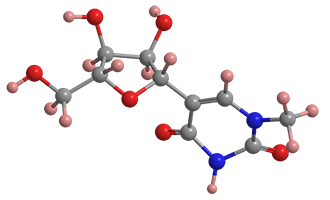What molecule am I?


N1-Methylpseudouridine (abbreviated m1ψ) and its unmethylated cousin pseudouridine1 (abbreviated ψ) are nucleosides and isomers of N1-methyluridine2 and uridine3, respectively. Both pseudouridines are components of transfer RNAs (tRNAs).
m1ψ and ψ are used to produce and mosify RNA vaccines. In particular, both played a role in the development of messenger RNA (mRNA) vaccines that were created to minimize the effects of the SARS-CoV-2 virus responsible for COVID-19.
In a 2021 article, Pedro Morais* at ProQR Therapeutics (Leiden, the Netherlands) and Hironori Adachi and Yi-Tao Yu* at the University of Rochester Medical Center (NY) wrote about the critical contribution that the pseudouridines played when Pfizer–BioNTech and Moderna Therapeutics developed the COVID vaccines in 2020. They wrote that m1ψ-modified mRNA encoded the SARS-CoV-2 spike protein and that the m1ψ modification also increased the vaccine’s efficacy compared with previously developed vaccines. Earlier positive results with ψ-modified RNA vaccines guided the drug companies’ efforts to develop COVID vaccines.
1. CAS Reg. No. 1445-07-4.
2. CAS Reg. No. 615-77-0.
3. CAS Reg. No. 58-96-8.
N1-Methylpseudouridine hazard information*
| Hazard class** | GHS code and hazard statement | |
|---|---|---|
| Acute toxicity, oral, category 4 | H302—Harmful if swallowed | |
| Skin corrosion/irritation, category 2 | H315—Causes skin irritation | |
| Serious eye damage/eye irritation, category 2A | H319—Causes serious eye irritation | |
| Specific target organ toxicity, single exposure, respiratory tract irritation, category 3 | H335—May cause respiratory irritation | |
*Most safety data sheets state “not a hazardous substance or mixture”, but one reports the data given here.
**Globally Harmonized System (GHS) of Classification and Labeling of Chemicals. Explanation of pictograms.
Molecules from the Journals
Silver selenide1 (Ag2Se) occurs in nature as the mineral naumannite; but the article of commerce is usually synthetic. An early preparation of Ag2Se was reported in 1902 by R. D. Hall and Victor Lehner at the University of Wisconsin (Madison), who reduced aqueous silver solutions with selenium to form the selenide salt. Other syntheses include melting the elements together and passing hydrogen selenide gas through silver solutions.
The β-crystal phase of Ag2Se is known to have semiconductor and thermoelectric properties. This past April, Kirill Kovnir and colleagues at Iowa State University (Ames), Ames National Laboratory, and the National Graduate School of Engineering of Caen (France) reported a benchtop route from silver chloride and elemental selenium to β-Ag2Se, which they then doped with 0.20–0.25 at% zinc. The safe, scalable, economical process produced materials with greatly enhanced thermoelectric performance compared with existing β-Ag2Se substances.
Propyne2, or methylacetylene, is the second simplest triple-bond hydrocarbon after acetylene itself. It was first described in 1882 by G. Harris Morris at Mason Science College (Birmingham, UK) in an article about constituents of “resin spirit” (i.e., liquids distilled from pine resins, among others).
Fast-forward to the Spage Age: In April, Theresa C. Marlin and collaborators at Caltech (Pasadena, CA), the Australian Nuclear Science and Technology Organisation (Lucas Heights), and NASA Goddard Space Flight Center (Greenbelt, MD) described features of propyne in the atmosphere of Saturn’s giant moon Titan. The molecule is photochemically produced as a gas in the upper atmosphere; but it condenses at lower altitudes. The authors reported X-ray diffraction and Raman spectroscopy results for crystalline propyne ice.
1. CAS Reg. No. 1302-09-6.
2. CAS Reg. No. 74-99-7.
Molecules from the Journals
MOTW briefly describes noteworthy molecules that appeared in recent ACS journal articles. See this week's
edition below.
This molecule was suggested by a reader. We present almost all of the molecules suggested by our readers. If you have a molecule you would like us to consider, please send us a message. And thank you for your interest in Molecule of the Week! —Ed.
N1-Methylpseudouridine fast facts
| CAS Reg. No. | 13860-38-3 |
| SciFindern name | 2,4(1H,3H)-Pyrimidinedione, 1-methyl-5-β-D-ribofuranosyl- |
| Empirical formula | C10H14N2O6 |
| Molar mass | 258.23 g/mol |
| Appearance | White to off-white crystals or powder |
| Melting point | 189 °C |
| Water solubility | 26 g/L |

Learn more about this molecule from CAS, the most authoritative and comprehensive source for chemical information.
Molecule of the Week needs your suggestions!
If your favorite molecule is not in our archive, please send us a message. The molecule can be notable for its current or historical importance or for any quirky reason. Thank you!
Stay Ahead of the Chemistry Curve
Learn how ACS can help you stay ahead in the world of chemistry.

